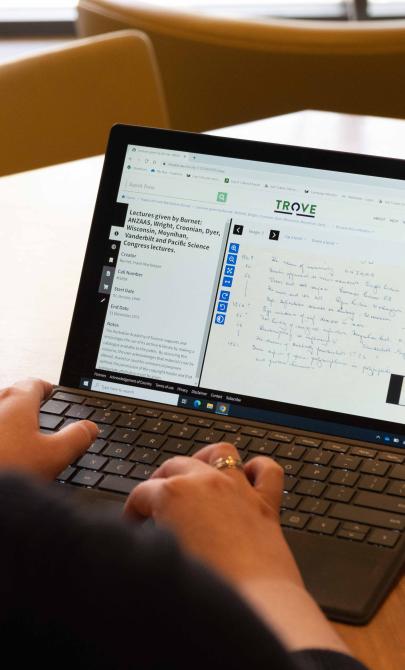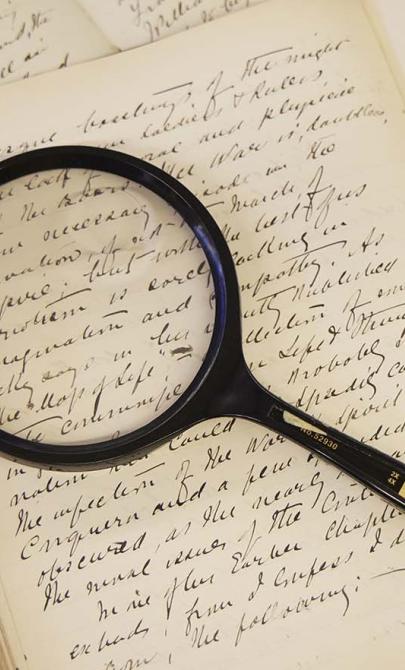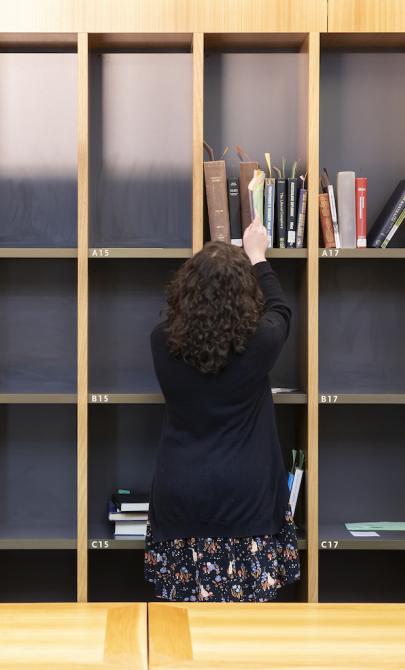Manning and Dymphna Clark Collection
Key items in the collection
Highlights from this collection demonstrate its historical significance and variety.
Papers of Manning Clark
The papers of Manning Clark form a very large archive. They extend back to 1907, but the bulk of the collection dates from 1950–91 when Clark lived in Canberra. The papers document virtually all his writings—books, articles, short stories, reviews, lectures, addresses and broadcasts—from 1931 to 1991 and include original manuscripts, later drafts, letters from publishers and members of the public, reviews, cuttings and research material. The research material for A History of Australia, filling 88 boxes, is the largest component in the archive. The papers also document Clark’s public and private life in great detail. There is an extensive general correspondence, diaries (1938–91), notebooks (1937–77), papers relating to overseas trips, subject files, newspaper cuttings, photographs and family correspondence. In addition, there are some papers on his teaching career, particularly in his later years at The Australian National University.
Papers of Dymphna Clark
The papers of Dymphna Clark contain an extensive correspondence dating from 1966 to 1999. Many of the pre-1991 letters were addressed to both Dymphna and Manning. Apart from the correspondence, the largest group of papers deal with her translation of the New Holland journal of Baron Charles von Hügel, describing his travels in Australia in 1833–34. The book was published in 1994. The papers include research material, articles and lectures on von Hügel, correspondence, reviews, newspaper cuttings and drafts of the English translation of the journal. There is also a typescript in German of von Hügel’s New Zealand journal.
Many of the post-1991 papers of Dymphna Clark relate to Manning Clark and particularly the attacks on his reputation as a writer and historian in the years after his death. There are correspondence and drafts of Speaking Out of Turn: Lectures and Speeches 1940–1991 (1997). Other papers include obituaries of Manning Clark, condolence letters and cards, photographs and newspaper cuttings.
Letters of Manning Clark Held in Other Manuscript Collections
Manning Clark maintained an extensive correspondence, including large numbers of postcards, with professional colleagues, writers and people who were prominent in public life. The following are some of the collections held in the Library that contain letters written by Clark:
- Papers of Alan Marshall, writer
- Papers of Humphrey McQueen, historian (restricted)
- Papers of Vivian Smith, poet and editor
- Papers of Eleanor Dark, novelist
- Papers of David Campbell, poet
- Papers of John La Nauze, historian
- Papers of Judith Wright, poet
- Papers of A.D. Hope, poet
- Papers of Dorothy Hewett, playwright and poet
- Papers of John Molony, historian
- Papers of David Martin, writer
- Papers of Frank Kellaway, teacher and writer
- Papers of Geoffrey Dutton, writer
- Papers of Russel Ward, historian
- Papers of Sir James Darling, headmaster
- Papers of William McMahon Ball, political scientist and diplomat
- Papers of Don Watson, historian and script writer
- Papers of Nicholas Hasluck, novelist
- Papers of Marion Halligan, novelist
- Papers of Gavin Souter, journalist and historian
- Papers of Noel Counihan, artist
- Papers of Geoffrey Fairbairn, historian
- Papers of Stuart Macintyre, historian
- Papers of John Barrett, historian
- Papers of Eric Fry, historian
- Papers of Peter Ryan, publisher and writer
- Papers of Patrick White, novelist
- Papers of Kylie Tennant, novelist and historian.
Manning Clark bequeathed to the Library a portrait of himself painted by Arthur Boyd at Wapengo in 1972. It is not currently in the Library as, under the terms of his will, it can remain with the family during the lifetimes of his children.
There are 93 photographs of the Clark family, dating from about 1910 to 1990. They include Manning Clark as a boy with his parents and brothers, Dymphna Clark as a girl, Manning Clark at Oxford in 1939, their home in Canberra, Manning and Dymphna with their young children, Manning in Moscow in 1959, and several images of Manning in his study. Other photographs of Manning Clark held by the Library include portraits by Alec Bolton, Jeff Carter, W. Pedersen and Heide Smith. There are several photographs of Clark in the Library, including a celebration of the life of David Campbell in 1989.
Correspondence
- Davies, Susan (ed.), Dear Kathleen, Dear Manning: the correspondence of Manning Clark and Kathleen Fitzpatrick 1949–1990, Melbourne University Press, Melbourne, 1996.
- Russell, Roslyn (ed.), Ever, Manning: selected letters of Manning Clark 1938–1991, Allen & Unwin, Sydney, 2008.
Biographical and Critical Works
- Armstrong, Judith. Dymphna, Australian Scholarly Publishing, Melbourne, 2016
- Bridge, Carl (ed.), Manning Clark: essays on his place in history, Melbourne University Press, Melbourne, 1994.
- Holt, Stephen, Manning Clark and Australian history 1915–1963, University of Queensland Press, Brisbane, 1982.
- Holt, Stephen, A short history of Manning Clark, Allen & Unwin, Sydney, 1999.
- Macintyre, Stuart and Clark, Anna, The history wars, Melbourne University Press, Melbourne, 2003.
- Macintyre, Stuart and Fitzpatrick, Sheila (eds), Against the grain: Brian Fitzpatrick and Manning Clark in Australian history and politics, Melbourne University Press, Melbourne, 2007.
- Matthews, Brian. Manning Clark: a life, Allen & Unwin, Sydney, 2008.
- McKenna, Mark. An eye for eternity: the life of Manning Clark, Miegunya Press, Melbourne, 2011.
- McQueen, Humphrey, Suspect history, Wakefield Press, Adelaide, 1997.
- Pascoe, Rob, The manufacture of Australian history, Oxford University Press, Melbourne, 1979.
- Ryan, Peter, Lines of fire: Manning Clark & other writings, Clarion Editions, Binalong, 1997.
About Manning Clark
Charles Manning Hope Clark (1915–1991) was born in Sydney. His family moved to Melbourne in 1924 and he was educated at Belgrave State School, Mont Albert Central School, Melbourne Grammar School and the University of Melbourne. He attended Oxford University in 1939 and while at Oxford he married Hilma Dymphna Lodewycks. They returned to Australia in 1940 and Clark taught at Geelong Grammar School before joining the staff of Melbourne University in 1944. In 1949 he was appointed the first Professor of History at Canberra University College. The college merged with The Australian National University in 1960 and Clark continued as Professor of History in the School of General Studies until 1971. He remained in the department as Professor of Australian History until his retirement in 1975. He was made a Companion of the Order of Australia in the same year.
Clark began lecturing in Australian history in 1946 and it was to be his passion for the rest of his life. In Melbourne he began collecting sources on Australian history, which led to his first publication, Select documents in Australian history 1788–1850 (1950). A second volume, covering the period 1850–1900, appeared in 1955. He then turned to writing his greatest work, A history of Australia. The first volume was published in 1962 and the sixth and final volume in 1987. His other books included Sources of Australian history (1957), Meeting Soviet man (1960), A short history of Australia (1963), Disquiet and other stories (1969), In search of Henry Lawson (1977) and The ideal of Alexis de Tocqueville (2000). He wrote three volumes of autobiography: The puzzles of childhood (1989), The quest for grace (1990) and A historian’s apprenticeship (1992).
Clark was the most famous Australian historian of his time. A history of Australia was the most ambitious work undertaken by a single historian and it attracted a very large audience. Readers admired or criticised his distinctive literary style and his preoccupation with grand themes, ideas and personal conflicts, rather than dry facts and figures. In his later years he accepted numerous invitations to write for newspapers, give lectures, broadcasts and interviews, and address organisations and societies throughout Australia. Some of his books and lectures provoked intense debate and his political statements and dire prophecies were often provocative.
About Dymphna Clark
Dymphna Clark (1916–2000) was born in Melbourne and was educated at Mont Albert Central School, Presbyterian Ladies’ College and the University of Melbourne. Her father was Associate Professor of Germanic Languages and her mother taught Swedish. Dymphna inherited their linguistic skills and could speak eight languages fluently. In 1938 she went to Germany to study German literature at Bonn University, but with war imminent she abandoned her studies and moved to Oxford, where she married Manning Clark. In the following decades, she devoted most of her energy to raising six children and supporting Manning, undertaking research, translations and proofreading of his major books. As the children grew up, she could spend more time on translation work, such as reports of the administration of German New Guinea (1896–1914) and the Australian journal of Baron Charles von Hügel (1833–34). After the death of Manning, she edited the third volume of his memoirs and his speeches and lectures, and established Manning Clark House as a cultural centre.
Background to the collection
Manning Clark had a long association with the Library and much of his research for A History of Australia was carried out in the Library. In the final volume he wrote, ‘The Petherick Room, the Manuscripts Room, and the Newspaper Room are present in every page of this volume, just as they are always present in my heart’. In 1989 he donated the first instalment of his papers under the Taxation Incentives for the Arts Scheme. Further papers were transferred in 1990–91. He bequeathed his remaining papers to the Library and they were received in 1994–95.
The photographs of Manning Clark and his family were lent for copying by Dymphna Clark in 1995. The papers of Dymphna Clark were donated by her son Sebastian Clark in 2003.
The Manning Clark papers are held in the Manuscripts Collection. They are arranged in 31 series. A finding aid is available online. The papers of Dymphna Clark are also in the Manuscripts Collection. They are arranged in 13 series. A finding aid is available online.
The family photographs and other photographs are held in the Pictures Collection. The copy prints of the family photographs are filed in Album 886 and a list is available in the Pictures Collection.
This guide was prepared using these references:
- Baker, Don, Manning Clark interviewed by Don Baker, 1985, ORAL TRC 1817.
- National Library of Australia, Guide to the papers of Manning Clark in the National Library of Australia, National Library of Australia, Canberra, 2002.
- Powell, Graeme, The Manning Clark Archives, Australian book review, no. 267, December 2004 – January 2005, p. 10.
- Rusden, Heather and Cham, Elizabeth, Dymphna Clark interviewed by Heather Rusden and Elizabeth Cham, 1990–91, ORAL TRC 2597.
- Russell, Roslyn, Dymphna Clark: a portrait, National Library of Australia news, vol. 15 (7), April 2005, pp. 11–14.
- Russell, Roslyn, Finding Manning Clark in the Letters, National Library of Australia news, vol. 18 (1), October 2007, pp. 15–18.



